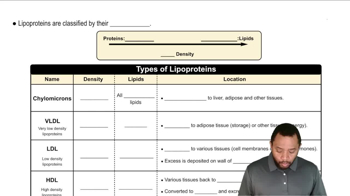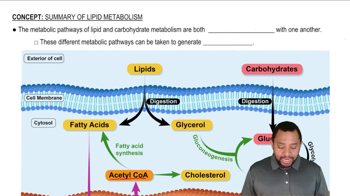Here are the essential concepts you must grasp in order to answer the question correctly.
Triacylglycerols (TAGs)
Triacylglycerols, also known as triglycerides, are a type of fat found in the body and are composed of three fatty acid molecules esterified to a glycerol backbone. They serve as a major form of energy storage and are transported in the bloodstream by lipoproteins. Understanding their structure and function is essential for grasping their role in metabolism and health.
Recommended video:
Triacylglycerols Concept 1
Very Low-Density Lipoproteins (VLDL)
Very Low-Density Lipoproteins are a class of lipoproteins that transport lipids, primarily triacylglycerols, from the liver to peripheral tissues. VLDL is synthesized in the liver and plays a crucial role in lipid metabolism. It is important to understand how VLDL functions in the body to comprehend the transport and distribution of fats.
Recommended video:
Lipoproteins for Transport Concept 2
Lipid Metabolism
Lipid metabolism refers to the biochemical processes involved in the synthesis and degradation of lipids in the body. This includes the formation of triacylglycerols, their storage, and their mobilization for energy. A solid understanding of lipid metabolism is necessary to explain the origin of triacylglycerols in VLDL and their significance in overall metabolic health.
Recommended video:
Summary of Lipid Metabolism Concept 1
 Verified step by step guidance
Verified step by step guidance Verified Solution
Verified Solution



 1:39m
1:39m